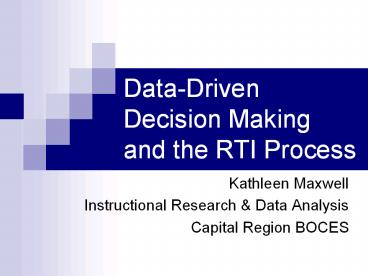Data-Driven Decision Making and the RTI Process PowerPoint PPT Presentation
1 / 17
Title: Data-Driven Decision Making and the RTI Process
1
Data-Driven Decision Making and the RTI Process
- Kathleen Maxwell
- Instructional Research Data Analysis
- Capital Region BOCES
2
IDEA 2004 Changes Procedures for Evaluating a
Child Suspected of Having a Learning Disability
- An LEA shall not be required to take into
consideration whether a child has a severe
discrepancy between achievement and intellectual
ability in oral expression, listening
comprehension, written expression, basic reading
skill, reading comprehension, mathematical
calculation, or mathematical reasoning. - An LEA may use a process that determines if the
child responds to scientific, research-based
intervention as a part of the evaluation
procedures.
3
Rationale for RTI
- an at-risk childs initial response to
remedial intervention can be a reasonably good
barometer of whether that child will be readily
remediated or difficult to remediate, andthe
profile developed from this and subsequent work
with the child can aid as a first-cut
diagnostic in determining whether his or her
reading difficulties are caused primarily by
experiential and instructional deficits or by
cognitive deficits of biological origin.
(Vellutino, Scanlon, Small, Fanuele, 2003)
4
RTI has three core concepts
- Application of scientific, research-based
interventions in general education - 2) Measurement of a students response to these
interventions and - 3) Use of the RTI data to inform instruction.
National Joint Committee on Learning
Disabilities, 2005
5
How are Data Used in RTI?
- School staff conduct universal screening of
academics behavior. - Continuous progress monitoring of students
performance occurs, pinpointing students
specific difficulties. - School staff use progress-monitoring data to
determine interventions effectiveness and to
make any modifications as needed.
6
Potential Benefits of RTI
- Earlier identification of students by means of a
problem-solving approach rather than by an
ability-achievement discrepancy formula - Reduction in the number of students referred for
special ed. and related services - Reduction in the over-identification of minority
students - Provision of more instructionally relevant data
than traditional means of identification
NJCLD, 2005
7
The RTI Process
8
Scientific Method
9
RTI/Problem-Solving Models
(Tilley, Reschly, Grimes, 1999)
10
Data Sources in theThree-Tiered RTI Model
- (from NJCLD, 2005)
11
- Tier 1 Preventive RTI
- Universal Screening
- Ongoing Progress Monitoring/CBA
- Differentiated Instruction Based on Assessment
(Gresham, 2005 NJCLD, 2005)
12
- Tier 1 Preventive RTI
- Universal Screening
- Ongoing Progress Monitoring/CBA
- Differentiated Instruction Based on Assessment
- Tier 2 Reactive RTI
- CBA Who still needs additional assistance?
- Frequent Progress Monitoring
- Assessment of Intervention Implementation
(Gresham, 2005 NJCLD, 2005)
13
Major Characteristics of a Curriculum-Based
Measurement Model
- Direct measurement observation of specific
student skills and behavior - Repeated measurement monitoring students
anywhere from 3X/week to 3X/year. - Time series analysis graphing the direct,
repeated measurement data, recording
instructional interventions on the graph,
looking at the students response to instruction.
(Wedl, 2005)
14
- Tier 1 Preventive RTI
- Universal Screening
- Ongoing Progress Monitoring/CBA
- Differentiated Instruction Based on Assessment
- Tier 2 Reactive RTI
- CBA Who still needs additional assistance?
- Frequent Progress Monitoring
- Assessment of Intervention Implementation
- Tier 3 SPED Eligibility RTI
- Evaluation using multiple measures
- Additional data, as needed
(Gresham, 2005 NJCLD, 2005)
15
- Tier 1 Preventive RTI
- Universal Screening
- Ongoing Progress Monitoring/CBA
- Differentiated Instruction Based on Assessment
- Tier 2 Reactive RTI
- CBA Who still needs additional assistance?
- Frequent Progress Monitoring
- Assessment of Intervention Implementation
- Tier 3 SPED Eligibility RTI
- Evaluation using multiple measures
- Additional data, as needed
SPED Identification
(Gresham, 2005 NJCLD, 2005)
16
Educators Must Develop New Skills to Use Data
Effectively
- General education teachers will need to compile
relevant assessment data through continuous
progress monitoring and respond appropriately to
the findings. - Special education and related services personnel
need to help design, interpret, and assess data
as well as suggest instructional approaches.
(NJCLD, 2005, p. 9)
17
Questions to Consider
- Which measures are most appropriate to identify
nonresponders at different points of reading
development, and what criteria determine movement
between tiers? - Is achievement determined by classroom, local,
state, or national norms, and/or by reaching
benchmarks? - How do you define expected achievement level, and
what is acceptable progress? - At what point will a student be deemed
nonresponsive to intervention? - How is the quality of the intervention monitored?

